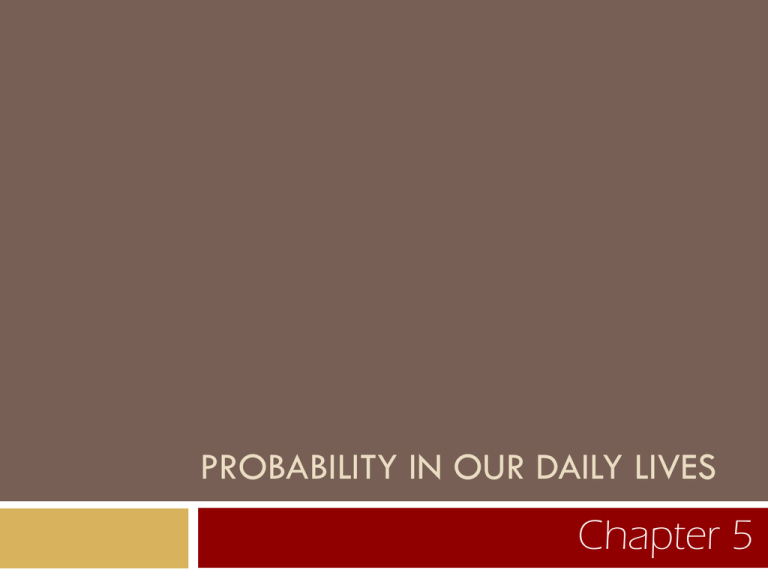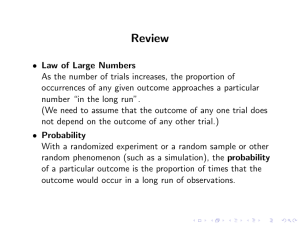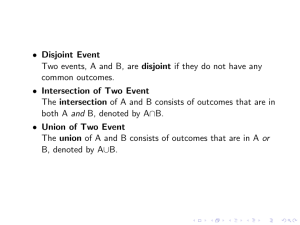Chapter 5 PROBABILITY IN OUR DAILY LIVES
advertisement

PROBABILITY IN OUR DAILY LIVES Chapter 5 5.1 How Can Probability Quantify Randomness? Random Phenomena Outcome is uncertain In the short-run, outcomes are highly random In the long-run, outcomes are very predictable Probability quantifies long-run randomness www.incomegambling.com Law of Large Numbers As # of trials increase, the proportion of an outcome approaches a particular number (probability): In the long run, 1/6 of die tosses is 6. Independent Trials Trials are independent if outcome of one trial is not affected by outcome of another If 20 heads in a row, you are not due a tail the probability is still 1/2 www.youthnoise.com How Can We Find Probabilities? oumathclub.files.wordpress.com Theoretical – We assume – some outcomes are equally likely Experimental – Observe many trials: use sample proportion to estimate probability Relative Frequency vs. Subjective Relative frequency definition of probability – proportion outcome occurs in very large number of trials Subjective definition – degree of belief outcome will occur based on available information i.cnn.net 5.2 How Can We Find Probabilities? Sample Space Sample Space – set of all possible outcomes Event - Subset of sample space, corresponding to one or a group of outcomes Probabilities for a Sample Space Each outcome has a probability All probability is between 0 and 1 Sum of all probabilities is 1 www.stathomeworkhelper.com Probability of an Event Probability of event A, P(A), is sum of outcome probabilities in event When all outcomes are equally likely: www.georgiamath1234.com # outcomes in A P( A) # outcomes in Sample Space Probability Rules of Pairs of Events In either or both events (Union) Union of A and B: A or B In both events (Intersection) Complement of A: AC Intersection of A and B: A & B Not in the event (Complement) Complement of Event A All outcomes in sample space not in A P(A) + P(Ac) = 1 So, P(Ac) = 1 – P(A) Disjoint Events A and B are disjoint if they have no common outcomes Intersection & Union of A and B Intersection is all outcomes in both A and B Union is all outcomes in either A or B or both Probability of Union of Two Events Addition Rule for the union of any two events, P(A or B) = P(A) + P(B) – P(A and B) If disjoint, P(A and B) = 0, so P(A or B) = P(A) + P(B) Chances of Being Audited? P(A and B) = ? when A is being audited and B is income of $100,000 or more Probability of Intersection of Two Events Multiplication Rule for intersection of two independent events, A and B, P(A and B) = P(A) x P(B) Assuming Independence A = 1st Question Correct B = 2nd Question Correct Don’t assume independence! www.youthcentral.vic.gov.au 5.3 Conditional Probability: Probability of A, Given B Conditional Probability Probability of event A, given that event B has occurred, is: P( A and B) P( A | B) P( B) The vertical slash represents the word “given”. Of the times that B occurs, P(A|B) is the proportion of times that A also occurs Probability Distribution Tax Forms by Income and Audit Status Probability of audit (event A), given income ≥ $100,000 (event B)? P(A and B) 0.0010 P(A | B) 0.007 P(B) 0.1334 www.csbgl.org Multiplication Rule for P(A and B) P(A and B) = P(A|B) x P(B) and P(A and B) = P(B|A) x P(A) workspace.novacentral.ca Independent Events Defined Using Conditional Probabilities Events A and B are independent if the probability one occurs is unaffected by whether other occurs Dependence Tests: P(A|B) = P(A) P(B|A) = P(B) P(A and B) = P(A) x P(B) www.psychologytoday.com 5.4 Applying the Probability Rules Is Coincidence Truly Unusual Event? Stonehenge blog.silive.com Law of Very Large Numbers – if something has very large number of opportunities to happen, occasionally it will happen, even if highly unusual Probability Model Unlike examples, deciding whether equally likely or independent is difficult We must specify a probability model that spells out assumptions Probability Model farm4.static.flickr.com Sensitivity = P(POS|S) Specificity = P(NEG|SC) Simulation Simulation is used for probabilities difficult to find with ordinary reasoning 1. Identify random phenomenon 2. Describe how to simulate 3. Repeat (at least 1000) 4. Summarize and state conclusion assets1.csc.com



